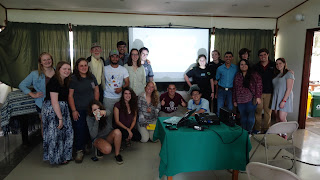What’s unique about the Monteverde Biological Station is that it lies at the convergence of two biological life zones – that of premontane wet forest and lower montane wet forest —and is surrounded by mostly primary forest. Because of this environment, we were able to catch the greatest number of different small mammal species so far: Oryzomys albigularis, Heteromys desmarestianus and nubicolens, Peromyscus nudipes, and Didelphus masupialis. On the transect located along edge forest, where a grass field met the trees, we had the most trapping success—on our first day, we had a 70% capture rate on that transect. On the other two transects within the dense primary forest, we had a good success rate but not near as high. We also had a more even ratio of males to females caught, as opposed to other areas where we’ve caught significantly more females than males; this could imply greater promiscuity amongst the species in this area, rather than polygamy (which we have observed in other areas).
While walking on the trails and setting traps, we could discern several features attributable to the areas’ dual life zones. Characteristic of the lower montane wet forest and premontane wet forest, the slopes over which we walked were constantly slick with mud, a sign of great amounts of precipitation in the form of rain and mist. This made hiking difficult, and landslides were a common sight throughout most of the transects as the unstable soil would give in to the weight of epiphyte-ridden trees. On one trail, we came across a massive landslide that had cleared a significant portion of the forest, and which residents at the station sworn to have heard occurring during a particularly rainy night.
Another factor typical of these life zones was the additional sighting of a small mammal caught on transect’s two camera trap (a Dasyprocta punctate, or Central American Agouti) along with other small mammals previously mentioned, mostly along the stream. Curiously enough, bird sightings were the only factor that decreased in number, something uncharacteristic of either ecotone; however, this might have been due to the weather associated with our hikes (cold and rainy/misty) which results in lower bird activity.
While the amount of physical activity at the station was minimal in comparison with our previous stops, the sense of adventure was as high as ever. Since the trails were mostly carved out by us (especially along the stream on transects two or three), we felt like true adventurers on the hunt for some rare specimen. The energy was high amongst everyone in the group, and we had fun watching each other undergo the occasional mud-covered fall, although these occurred more often than many of us would’ve liked. It was a truly enriching experience, and it set the bar for adventurous hikes at our next stop: San Gerardo.
Pura Vida!


No comments:
Post a Comment